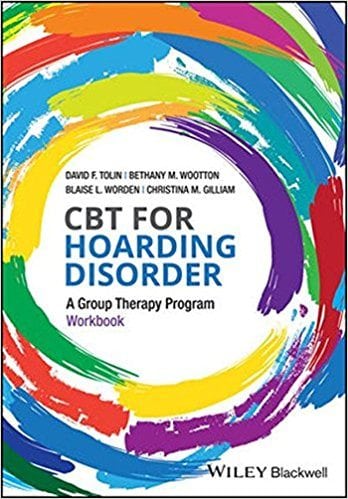Movies and television have long featured people suffering from common mental health conditions. Hoarding disorder has been highlighted on “The Dr. Oz Show,” “The Oprah Winfrey Show and the A&E series “Hoarders.”
Although these representations may focus on extreme examples of people suffering from hoarding disorder, they often attempt to address the misconception that hoarders are lazy or sloppy by showing that hoarding disorder is a legitimate mental illness that requires treatment. Fortunately, there is now evidence that people with hoarding disorder can be helped.
“CBT for Hoarding Disorder: A Group Therapy Program,” a two-volume book on the condition authored by David Tolin, Blaise Worden and Christina Gilliam from the Institute of Living along with former IOL post-doctoral fellow Bethany Wootton, offers an evidence-based treatment approach and practical steps to help people living with hoarding disorder.
The book, available now for pre-order before its release next month, offers a comprehensive cognitive behavioral therapy approach for people struggling with hoarding disorder, which includes a guidebook for therapists and a workbook for patients.
“Hoarding disorder is a relatively new diagnosis in the diagnostic and statistical manual of mental disorders (DSM-5) that is characterized by difficulty letting go of possessions or discarding possessions, resulting in clutter that impacts a person’s ability to function or be safe in their home,” said Dr. Tolin. “The best estimate we have is that about three percent of adults in the United States suffer from hoarding disorder.”
Until recently, a person with hoarding disorder was treated the same way as a person with obsessive compulsive disorder (OCD). That approach proved disappointing because hoarding and OCD are different. For example, people with hoarding disorder often do not have obsessive thoughts and compulsive behaviors that we typically associate with OCD.
“We’ve developed a new model of understanding hoarding that largely focuses on problems of emotion regulation and difficulty with effective decision making,” Tolin said. “As a result, we have conducted research using cognitive behavioral therapy, which is a form of counseling that involves teaching people how to apply new patterns of behavior and to challenge maladaptive ways of thinking. We have tested it in the group therapy setting and found that it is effective in a controlled trial.”
“CBT for Hoarding Disorder” is expected to make an immediate impact on clinical practice because it is an approachable source of best practices.
“Clinicians in our field often use treatment manuals as a guide for implementation of effective treatments,” said Dr. Worden. “Since research efforts on hoarding disorder are relatively new in the field, there are very few protocols or manuals to guide mental health providers as they treat hoarding disorder. In our research and that of our colleagues, we have found our cognitive-behavioral hoarding treatment to be among the most effective of treatments available, and we are happy to share it with mental health providers and the scientific community as a whole.”
The Institute of Living’s Anxiety Disorders Center has long been a pioneer in understanding and treating this condition.
“We are one of the few sites in the nation that does both treatment and research on hoarding and related issues, and we have been doing so for almost two decades,” said Dr. Worden. “I’m proud to be a part of it.”
Tolin was eager to highlight the exceptional team effort that went into the creation of this resource for therapists and patients.
“Each member of our team contributed a unique perspective based on their own work in the area of hoarding disorder,” Tolin said, “both from their scientific work and clinical experience. It ended up being a lengthy negotiation about how best to treat this. We all learned a lot along the way, and that has made the final product stronger.”
For more information on the hoarding program at the Institute of Living, click here.

